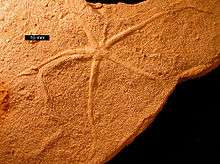Asteriacites

Asteriacites lumbricalis, a trace fossil of an ophiuroid echinoderm; Carmel Formation (Middle Jurassic), near Gunlock, Utah
Asteriacites is the name given to five-rayed trace fossils found in marine sedimentary rocks (Mángano et al., 1999; Wilson and Rigby, 2000). They record the burrows of ophiuroid and asteroid sea stars on the sea floor. Asteriacites are found in European and American rocks, from the Ordovician period onwards, and are especially numerous in the Jurassic system.
Gallery
-

Asteriacites from the Devonian of northeastern Ohio; this trace was made by an asteroid echinoderm
-

Bedding plane view of Asteriacites from the Snapper Point Formation (Permian), New South Wales
References
Further reading
- Mángano, M.G.; Buatois, L.A.; West, R.R.; Maples, C.G. (1999). "The origin and paleoecologic significance of the trace fossil Asteriacites in the Pennsylvanian of Kansas and Missouri". Lethaia. 32: 17–30. doi:10.1111/j.1502-3931.1999.tb00577.x.
- Wilson, M.A.; Rigby, J.K. (2000). "Asteriacites lumbricalis von Schlotheim 1820: ophiuroid trace fossils from the Lower Triassic Thaynes Formation, central Utah". Ichnos. 7: 43–49. doi:10.1080/10420940009380145.
External links
| Wikimedia Commons has media related to Asteriacites. |
| Phanerozoic Eon | |||||||||||
|---|---|---|---|---|---|---|---|---|---|---|---|
| Paleozoic Era | Mesozoic Era | Cenozoic Era | |||||||||
| Cambrian | Ordovician | Silurian | Devonian | Carboniferous | Permian | Triassic | Jurassic | Cretaceous | Paleogene | Neogene | 4ry |
This article is issued from Wikipedia - version of the 10/16/2016. The text is available under the Creative Commons Attribution/Share Alike but additional terms may apply for the media files.